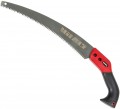Density of teeth in a complete saw blade; measured as the number of teeth per blade length inch (TPI).
The higher the TPI, the smaller each individual tooth, and vice versa. Other things being equal, large teeth allow you to cut easily and quickly, but not very accurately; small — provide an accurate and clean cut, but at the cost of increased effort and time. Accordingly, when choosing a saw for this parameter, one must proceed from the fact that in this case it is more important — speed or accuracy. In addition, the TPI determines suitability for small workpieces: the smallest allowable log thickness is considered to be a three-tooth pitch. For example, in a 9 TPI saw, three teeth will take up 1/3", or approximately 8.5 mm.
It is worth remembering that only tools of the same type and purpose can be compared by the number of teeth per inch. So, for example, in standard saws for wood, the minimum TPI value is 4, and already in
passer saws — 9. The most coarse-toothed today are saws for foam concrete — they have about 1.2 – 1.8 teeth per inch; and the “record holders” in terms of density are saws for metal and
jigsaws, for which the TPI value of 24 is almost the standard.
The presence of hardened teeth in the saw blade (in models with removable blades — at least one of the complete blades).
Hardened teeth usually have a characteristic dark coating that stands out from the base material of the blade. They have increased hardness and strength, which significantly increases the life of the hacksaw before blunting. On the other hand, it is impossible to re-sharpen a tool with such teeth — you will have to change either the entire hacksaw, or at least the blade.
The presence
of a cover in the scope of delivery of a hacksaw.
The cover will be useful for storing and transporting the tool: it closes the saw almost entirely (there is usually only a handle outside), protecting the blade and frame (if any) from dirt, moisture and contact with foreign objects. The latter allows you to safely carry the saw in the same bag with other things. Regular covers, usually, are much more convenient than improvised devices (like a rag in which the canvas is wrapped), and are generally inexpensive.
